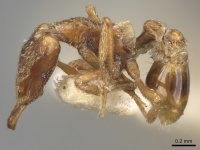Strumigenys forficata
| Strumigenys forficata | |
|---|---|

| |
| Scientific classification | |
| Kingdom: | Animalia |
| Phylum: | Arthropoda |
| Class: | Insecta |
| Order: | Hymenoptera |
| Family: | Formicidae |
| Subfamily: | Myrmicinae |
| Tribe: | Attini |
| Genus: | Strumigenys |
| Species: | S. forficata |
| Binomial name | |
| Strumigenys forficata Brown, 1959 | |
Nothing is known about the biology of Strumigenys forficata.
Identification
Bolton (2000) - A member of the signeae complex in the Strumigenys godeffroyi-group. The Bornean S. forficata remains known only from the original collection. It is grouped here with Strumigenys esrossi, Strumigenys degonya and Strumigenys ortholex because of its extremely reduced pilosity but it is apparent that the species have reached this condition independently. Differentiation of the three is easy as forficata has short mandibles (MI 35) with a lamella on the inner margin, lacks sculpture on the side of the alitrunk, and has a smooth postpetiole disc. S. esrossi, degonya and ortholex have longer mandibles (MI 41-48) without a lamella on the inner margin, have the entire side of the alitrunk reticulate-punctate, and have a strongly sculptured postpetiole disc. The last three are quickly separated because degonya has a concave ventrolateral margin of the head in front of the eye and completely sculptured first gastral tergite; and ortholex has flagellate hairs on the postpetiole and first gastral tergite.
Keys including this Species
Distribution
Distribution based on Regional Taxon Lists
Indo-Australian Region: Borneo (type locality), Indonesia, Malaysia.
Distribution based on AntMaps
Distribution based on AntWeb specimens
Check data from AntWeb
Countries Occupied
| Number of countries occupied by this species based on AntWiki Regional Taxon Lists. In general, fewer countries occupied indicates a narrower range, while more countries indicates a more widespread species. |

|
Estimated Abundance
| Relative abundance based on number of AntMaps records per species (this species within the purple bar). Fewer records (to the left) indicates a less abundant/encountered species while more records (to the right) indicates more abundant/encountered species. |

|
Biology
Castes
Nomenclature
The following information is derived from Barry Bolton's Online Catalogue of the Ants of the World.
- forficata. Strumigenys forficata Brown, 1959g: 86 (w.) BORNEO. See also: Bolton, 2000: 821.
Unless otherwise noted the text for the remainder of this section is reported from the publication that includes the original description.
Description
Worker
Bolton (2000) - TL 2.7, HL 0.68, HW 0.52, CI 76, ML 0.24, MI 35, SL 0.38, SI 73, PW 0.28, AL 0.76. Characters of signeae-complex. Inner margin of relatively short mandible with a convex-edged clear lamella, at its maximum width the lamella slightly less than maximum length of preapical tooth. Apicoscrobal hair absent; dorsolateral margin of head in full-face view with a row of small, closely applied spatulate hairs on the upper scrobe margins, without freely laterally projecting hairs anywhere. Upper scrobe margin very broad and forming a well defined lamella; the eyes not visible in full-face view. Cephalic dorsum with reclinate narrowly spatulate ground-pilosity but without erect hairs, even the usual row near the occipital margin absent. Dorsal alitrunk with a few small spatulate hairs at anterior margin of pronotum; without standing hairs anywhere, without a pronotal humeral hair. Dorsal surfaces of petiole and postpetiole without standing hairs. Base of first gastral tergite with a transverse sparse row of small flattened hairs near the limbus, these hairs strongly inclined anteriorly; first gastral tergite otherwise without standing hairs. Dorsum of pronotum and anterior mesonotum smooth, surface posterior to this with feeble punctulate sculpture. Entire side of alitrunk unsculptured, smooth and shining. Lamella on propodeal declivity broad, a vestige of the propodeal tooth visible within the lamella and the lamella present above the level of the tooth. Dorsum of petiole node and disc of postpetiole smooth and shining. With petiole in profile the lateral spongiform lobe extends anteriorly to very near the anterior face of the node. Basigastral costulae fine and dense on limbus, very short on tergite proper, shorter than width of limbus.
Type Material
Bolton (2000) - Holotype worker, MALAYSIA: "Borneo", Mt Murud (E. Mjoberg) (Museum of Comparative Zoology) [examined].
References
- Bolton, B. 2000. The ant tribe Dacetini. Memoirs of the American Entomological Institute. 65:1-1028. (page 821, redescription of worker)
- Brown, W. L., Jr. 1959g [1958]. The Indo-Australian species of the ant genus Strumigenys Fr. Smith: group of S. godeffroyi in Borneo. Psyche. 65:81-89. (page 86, worker described)
References based on Global Ant Biodiversity Informatics
- Brown W. L., Jr. 1959. The Indo-Australian species of the ant genus Strumigenys Fr. Smith: group of S. godeffroyi in Borneo. Psyche (Camb.) 65: 81-89.
- Pfeiffer M.; Mezger, D.; Hosoishi, S.; Bakhtiar, E. Y.; Kohout, R. J. 2011. The Formicidae of Borneo (Insecta: Hymenoptera): a preliminary species list. Asian Myrmecology 4:9-58

